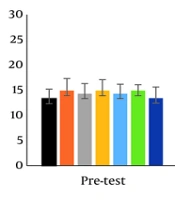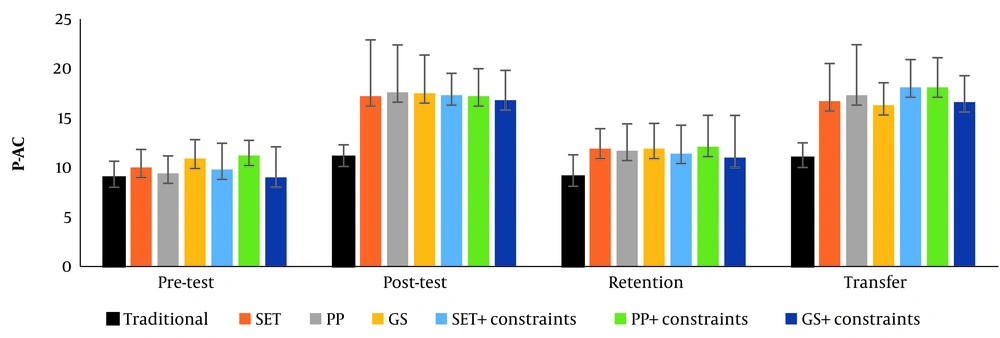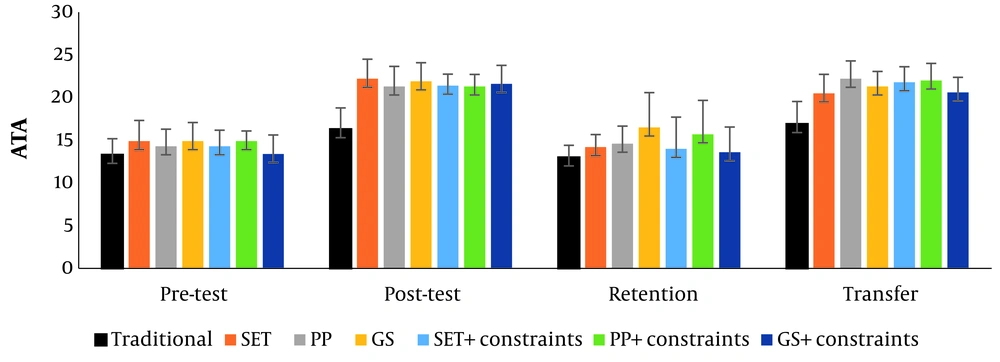1. Background
The special feature of dynamic group games is that different actions may be taken in countless situations that cannot be predicted in advance. These events are countless in soccer. In this case, successful football players are those who have a wide set of functions and adapt them in response to different situations. In other words, players will have an advantage if they respond in an unconventional way or to the individual. These actions are called creative actions when appropriate (1). As a result, motor skills learning methods should be effective in terms of increasing players' performance, adaptability, creativity and also stimulate this ability (2). Arguments from the ecological dynamics approach are that the player's efforts to adapt to individual constraints require creativity. This creativity originates from the constraints of the task and the environment and the individual that are dynamically interacting (2, 3). It is argued that interactive constraints create high variability in actions when creative actions emerge during the game (4, 5). This contrasts with more traditional, cognitive approaches (6, 7), who argue that action follows an internal and mental process of ideation that results from individual creativity.
From different theoretical approaches, different motor learning methods emerge. In the traditional approach, the process of acquiring internal motor representations that control movement execution constitutes motor learning (8-10). On the other hand, the ecological dynamics approach believes that individual, task, and environmental constraints cause motor learning that dynamically interact (11, 12). Therefore, constraints can be viewed as limitations, boundaries or design features that apply restrictions to the organization of the degrees of freedom residing at the different levels of the movement system (13). A football player who is in possession of the ball would have to decide to either shoot at goal, pass to a team-mate, or dribble the ball to gain an advantage over her competitors. To be successful, the player would not only have to consider how far away the goal is, but also how accurately and with what force she can shoot the ball (i.e., personal constraints), while having to take the current position and (future) movements of her team mates and opponents into account. It is dynamic sporting situations like these that typically provide a rich landscape of ever-changing opportunities for action, or affordances, not only because the situational constraints are constantly changing, but also because of the movements of the players within the situation. In other words, affordances emerge and dissolve on a moment-to-moment basis with the pressure on players to make decisions that select the most appropriate action responses in order to be successful within the current situation.
Perception-action coupling (P-AC) use of information to support movements requires a control rule that continuously relates the individual's current state to the state of the environment (14). The underlying factors of expertise in sports performance have received much attention in the past few decades. Researchers argue that at the highest level of competition in sports, cognitive and perceptual skills play an important role in performance (15). According to Mann et al. (16), ability to obtain information related to the presented situation in order to choose and implement appropriate actions depends on the athlete's perceptual-cognitive skills. In a study, Santos et al. (17) compared under 13 and 15 soccer players who practiced in small-sided games with either nonlinear pedagogy (NLP) or differential learning (DL) methods. The findings showed that the DL methods resulted in enhanced development of creativity, in particularly there were more actions, a greater number of different actions and more actions designated as original.
The research findings of the use of technique-based models in teaching sports skills show that this model only increases general skills and the level of preparation in games such as football, but the players fail in transferring the skills to the real conditions of the game. Research findings using tactics-based models such as teaching game for understanding (TGFU) to show players are able to make good decisions in games as well as students of their news and procedures, but in contrast, findings show that players are able to execute skills in game situations (18). Tactics-based training leads to learning and improving tactical performance, and technique training leads to learning and technical improvement. To overcome this problem, Hopper (19) suggests that TGFU can be combined with the technical model to form an effective teaching approach, and researchers should not waste time comparing technical versus tactical approaches. It should be noted that, Nathan et al. (18) have also introduced the style E tactical (SET) to solve this aspect of the TGFU approach. In 2001, Launder (20) published the book "play practice". An approach that is very similar to TGFU in terms of pedagogy principles and goals; but play practice (PP) differs from the TGFU approach (21). Launder (20) defines skilled play as a combination of game logic and technical ability. He defines the concept of the game as, "the ability to use the understanding of rules, tactics and strategies and to solve the problems that arise in the sport or by the opponents". The game sense (GS) approach is a modified form of the TGFU education model developed by Bunker and Thorpe (22), which is a student-centered method and uses games to make the educational environment very attractive for students and increase students' ability.
In the football game, the perception of situational conditions and action is the basic condition for success. The type and manner of training by coaches to increase coordination, and following that perception can lead scientists to appropriate training methods to achieve this goal. Which of the non-linear or linear training styles can increase the ability of P-AC in soccer players is of great importance among coaches. Also, the use of new pedagogy approaches in football training may be able to increase the level of perception, increase the performance of the game and develop the skills of football players.
2. Objectives
Therefore, the aim of the present study is to investigate effect of linear and non-linear training and constraints on the P-AC of football players.
3. Methods
3.1. Subjects
The statistical population of this research is male undergraduate students of Urmia University (mean age = 22.30, SD = 1.70) who had a physical education course unit in the first semester of the academic year 2021 - 2022. Among the participants, 70 male students were selected based on the results of the personal information questionnaire, such as the history of playing football. Therefore, none of the participants should have a history of playing football. The participants were randomly divided into seven (SET, PP, GS), SET with constraints, PP with constraints, GS with constraints and traditional) equal groups (n = 10).
3.2. Procedures
In-situ condition, laboratory-based condition free-kick task is used to measure the P-AC (23). The groups trained for six weeks, with three sessions per week, each lasting 60 minutes. One day after the final training session, the post-test was conducted, which included a free kick test identical to the pre-test. Participants then refrained from any soccer-related training for two weeks. After this period, a retention test (similar to the pre-test and post-test) was administered, and the participants took part in it on the following day.
3.3. Data Analysis
Shapiro-Wilk test is used to investigation the normality of data distribution. In this research, Levene test is used to check the homogeneity of variances. First, 7 (group) × 4 (phase) mixed ANOVA used to investigation the hypotheses to determine the effectiveness of pedagogy models on the promotion of research factors. Then, the one-way ANOVA for between- group and ANOVA with repeated measures for within- group comparsions used.
4. Results
The results of the mixed ANOVA of the P-AC and ATA are presented in Table 1. For both P-AC and ATA show that the effect of time, the interaction effect of time × group and the effect of group is significant. Within group comparison shows a significant difference in the variables of P-AC (Figure 1) and ATA (Figure 2) between pre-test and post-test, as well as between pre-test and transfer (P < 0.05) (Table 2).
| Variables and Category | Sum of Squares | DF | Mean Squared | F | Sig. | Partial Eta Squared |
|---|---|---|---|---|---|---|
| P-AC | ||||||
| Time | 2377.486 | 3 | 792.495 | 112.906 | 0.001 | 0.642 |
| Time × group | 216.914 | 18 | 12.051 | 1.717 | 0.039 | 0.141 |
| Group | 581.571 | 6 | 96.929 | 6.111 | 0.001 | 0.368 |
| ATA | ||||||
| Time | 2875.782 | 2.456 | 1171.142 | 182.520 | 0.001 | 0.743 |
| Time × group | 172.843 | 14.733 | 11.732 | 1.828 | 0.036 | 0.148 |
| Group | 393.271 | 6 | 65.545 | 11.027 | 0.001 | 0.512 |
Results of Mixed ANOVA Test for Perception-Action Coupling and Actual Target Area
| Group | Sum of Squares | DF | Mean Squared | F | Sig. | Partial eta Squared |
|---|---|---|---|---|---|---|
| P-AC | ||||||
| Traditional | 40.100 | 3 | 13.367 | 10.491 | 0.001 | 0.538 |
| SET | 379.300 | 3 | 126.433 | 12.495 | 0.001 | 0.581 |
| PP | 503.00 | 3 | 167.667 | 15.996 | 0.001 | 0.640 |
| GS | 314.700 | 3 | 104.900 | 18.907 | 0.001 | 0.678 |
| SET+ constraints | 520.100 | 1.741 | 298.671 | 29.645 | 0.001 | 0.767 |
| PP+ constraints | 368.100 | 3 | 122.700 | 21.882 | 0.001 | 0.709 |
| GS+ constraints | 469.100 | 3 | 156.367 | 15.247 | 0.001 | 0.629 |
| ATA | ||||||
| Traditional | 121.275 | 3 | 40.425 | 9.493 | 0.001 | 0.513 |
| SET | 479.300 | 3 | 159.767 | 34.593 | 0.001 | 0.794 |
| PP | 537.400 | 3 | 179.133 | 51.127 | 0.001 | 0.850 |
| GS | 362.700 | 1.596 | 227.186 | 16.587 | 0.001 | 0.648 |
| SET+ constraints | 556.275 | 1.375 | 404.657 | 28.289 | 0.001 | 0.759 |
| PP+ constraints | 408.875 | 1.561 | 261.948 | 22.803 | 0.001 | 0.717 |
Results of ANOVA with Repeated Measures in Each Group for Research Variables
The results of the one-way ANOVA test (Table 3) showed that there is a significant difference between the research groups in the variable of P-AC and ATA in the post-test and transfer phase (P < 0.05).
| Variables and Time | Sum of Squares | DF | Mean Squared | F | Sig. |
|---|---|---|---|---|---|
| P-AC | |||||
| Pre-test | 45.800 | 6 | 7.633 | 1.679 | 0.141 |
| Post-test | 329.886 | 6 | 54.981 | 4.120 | 0.001 |
| Retention | 64.600 | 6 | 10.767 | 1.270 | 0.284 |
| Transfer | 358.200 | 6 | 59.700 | 5.660 | 0.001 |
| ATA | |||||
| Pre-test | 28.886 | 6 | 4.814 | 1.197 | 0.320 |
| Post-test | 248.971 | 6 | 41.495 | 9.555 | 0.001 |
| Retention | 88.486 | 6 | 14.748 | 1.627 | 0.154 |
| Transfer | 199.771 | 6 | 33.295 | 7.795 | 0.001 |
One-way ANOVA Test Results to Compare Perception-Action Coupling and Actual Target Area in Research Groups
The results of Bonferroni post hoc test (Table 4) showed that there is a significant difference between the traditional group and other groups in the post-test and transfer of the variable of P-AC and ATA, and the traditional group had a weaker performance than the other groups. But there is no significant difference between other groups at different times.
| Variables | Group I | Group J | Mean Difference | Standard Error | Sig. |
|---|---|---|---|---|---|
| Post-test P-AC | Traditional | SET | -6.100 | 1.63367 | 0.009 |
| PP | -6.500 | 1.63367 | 0.004 | ||
| GS | -6.400 | 1.63367 | 0.005 | ||
| SET+ constraints | -6.200 | 1.63367 | 0.007 | ||
| PP+ constraints | -6.100 | 1.63367 | 0.009 | ||
| GS+ constraints | -6.100 | 1.63367 | 0.009 | ||
| Transfer P-AC | Traditional | SET | -5.700 | 1.45242 | 0.005 |
| PP | -6.300 | 1.45242 | 0.001 | ||
| GS | -5.300 | 1.45242 | 0.011 | ||
| SET+ constraints | -7.100 | 1.45242 | 0.001 | ||
| PP+ constraints | -7.100 | 1.45242 | 0.001 | ||
| GS+ constraints | -5.600 | 1.45242 | 0.006 | ||
| Post-test ATA | Traditional | SET | -5.900 | 0.93197 | 0.001 |
| PP | -5.00 | 0.93197 | 0.001 | ||
| GS | -5.600 | 0.93197 | 0.001 | ||
| SET+ constraints | -5.100 | 0.93197 | 0.001 | ||
| PP+ constraints | -5.00 | 0.93197 | 0.001 | ||
| GS+ constraints | -5.300 | 0.93197 | 0.001 | ||
| Transfer ATA | Traditional | SET | -3.600 | 0.92428 | 0.005 |
| PP | -5.300 | 0.92428 | 0.001 | ||
| GS | -4.400 | 0.92428 | 0.001 | ||
| SET+ constraints | -4.900 | 0.92428 | 0.001 | ||
| PP+ constraints | -5.100 | 0.92428 | 0.001 | ||
| GS+ constraints | -3.700 | 0.92428 | 0.004 |
Bonferroni Post Hoc Test Results for Comparing Groups in Perception-Action Coupling and Actual Target Area Variable
5. Discussion
In modern soccer, free kicks are important scoring opportunities. In soccer free kick situations, goalkeepers usually place a wall of two or more players between the ball and the goal. The goal of the wall is to cover a large part of the goal while the goalkeeper covers the remaining part (24). It is important to examine the effect of the role of pedagogy and the type of training on the P-AC in soccer free kick tasks.
Following ecological psychology theory and recent theories of embodied cognition, we expect that although the time demands of intercept prediction tasks in sport are different, but variation in the degree of P-AC affects decision making in less time on consuming tasks such as free kicks in soccer. Recent studies have emphasized the importance of P-AC for the outcomes of perceptual-cognitive processes in sports performance, but the evidence is mainly limited to prediction and decision-making in external and time-related tasks (25, 26). Therefore, the aim of the present study is the effect of football training using traditional, SET, PP, GS pedagogy approaches and constraints on the P-AC. These results showed that football training using SET, PP, GS pedagogy approaches and constraints has an effect on the P-AC. In other words, non-linear training groups and constraints performed better than the traditional group from pre-test to post-test and transfer stage. Although no study was found in the research literature that carefully examines the impact of football training using traditional, SET, PP, GS pedagogy approaches and constraints on P-AC, but these results are in some ways consistent with the findings of Paterson et al. (27). The aim of their study was to investigate the effect of P-ACon perceptual decision-making in a self-paced far aiming task. The variation in participant decisions across conditions suggests that P-AC is an important factor to consider when studying decision-making in self-paced far aiming task tasks. It is argued that this is most likely due to the perceptual decisions that are made in action, i.e., they are inherently limited by the action capabilities of the perceiver. More recently, Alcock (28) analyzed direct free kicks in the 2007 FIFA Women's World Cup. The results showed that in the matches, the upper corners of the goal were often chosen, but depending on the position of the goalkeeper and the wall, the more central areas (equivalent to current TA3 and TA5 in this research) were difficult options to save the goal. Therefore, considering that the non-linear training exercises are closer to competitive conditions and are far from traditional conditions, these results can be explained in such a way that training in non-linear methods improves the ability to make decisions in the moment and the performance of soccer free kicks in this groups develop better than traditional groups.


